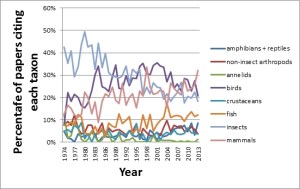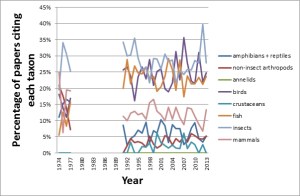
Recently, we commissioned one of Journal of Animal Ecology‘s most experienced Associate Editors, Simon Leather, to compile a Virtual Issue on his great passion – insects. The journal has published many classic insect ecology papers over the years and Simon does a great job of highlighting some of these as well as many new papers that we hope will go on to become classics themselves. In his preface to the VI, Simon bemoans the fact that back in the 1970s, when he first began subscribing to the journal, there were many more papers on insects than there are now and that the journal has perhaps become vertebrate-centric in recent years.
This got me thinking – is this really true? And if it is, then why do we publish fewer entomological papers now than back then? Are we alone in this trend or is it common across other general ecological journals? And, either way, should we be worried about the taxonomic distribution of our papers?
The data
As a scientist, I’m not a great fan of anecdotes so I wanted some quantitative data to answer these questions. I went to Web of Science and used a key word search to establish how many papers Journal of Animal Ecology published over the last 40 years on insects and other taxonomic groups. For comparison, I did the same for the ESA journal, Ecology. To account for year to year variation in the number of papers published, I simply calculated the percentage of papers in each category. So, what did I find?
The results
Annoyingly, Simon was correct – as usual (Figure 1). Over the last 4 decades, the number of papers JAE published that included ‘insect’ as a key word has roughly halved: in the 1970s, more than 40% of our papers included insects, whereas in the 2010s it averages at around 20%. Other invertebrate taxa (crustaceans, annelids and non-insect arthropods such as spiders) have either remained constant over time or have also declined slightly.
By contrast, the number of vertebrate papers has increased over the same period. For example, the proportion of papers that include mammals has nearly doubled in the last 40 years, from about 14% to 26%; bird papers increased from about 15% to 30% between the 1970s and 1990s, and has since either stabilised or declined slightly; and the number of fish papers has increased from about 7% to 12%. Of course, many of the papers we publish will include multiple taxa, perhaps even whole communities, so we need to interpret these findings with some caution.
Figure 1. Trends in the number of citations per taxon in Journal of Animal Ecology.
This lead to me to wonder whether this trend is shared by other ecological journals and can therefore be explained by genuine changes among the research community. Perhaps the priorities of funding agencies have changed, such that researchers are increasingly working on charismatic mega-faunae to the detriment of more numerous (and some might say, more interesting!) smaller organisms like insects? Or maybe researchers simply can study vertebrates more easily these days with the increased availability of techniques and tools such as remote sensing and bio-logging, for example.
A comparison with our US counterpart, Ecology, suggests that these taxonomic shifts are not universal (Figure 2), and similar trends are seen for Oikos (data not shown). For none of the 8 taxa I searched for was there a major temporal change in its frequency of occurrence in this journal, though as an aside it is noteworthy that whereas JAE now publishes around twice as many papers on mammals as fish, for Ecology this trend is reversed, so each journal has its own taxonomic biases!
Figure 2. Trends in the number of citations per taxon in Ecology (data for the period 1978-1990 are excluded due to poor data quality).
Potential explanations for the trends
So, what has brought about the demise in invertebrate studies published in JAE and the upsurge in vertebrate studies?
In his preface to the VI, Simon alludes to potential biases in the senior editors of the journal. Back in the 1970s, the journal editors were often entomologists, whereas latterly they have often been dominated by vertebrate ecologists. However, there has been a fairly frequent turnover of senior editors over this period, and until very recently, the 4 senior editors were evenly split between those that work mostly invertebrates (Mike Boots & Ken Wilson) and those that study vertebrates (Tim Coulson & Graeme Hays).
Based on my own personal experiences as a senior editor, I certainly do not believe there has been any great conspiracy to exclude insects or to promote mammals. Every paper reviewed by JAE is sent to experts in their respective fields and I do not feel that entomologists are any harder on their fellow ecologists than are mammalogists. Of course, we cannot exclude the possibility that senior editors (or associate editors or reviewers), subconsciously favour taxa close to their hearts at the expense of other taxa.
I suspect, however, that the change is more a reflection of the subject areas that these taxa are the subject of. We probably publish more papers now in the fields of demography, evolutionary ecology, spatial ecology and disease ecology, and these are fields that tend to be dominated by vertebrate systems. These may also appear to be more novel when vertebrate systems are involved and the authors use fancy technological, modelling or statistical tools. So, the challenge for entomologists is to ensure that their studies have sufficient novelty to compete in a highly competitive environment (JAE currently rejects around 85% of the manuscripts we receive). Acceptance rates for insect papers are similar to those for papers on birds and mammals, so the number of entomological papers we publish reflects the number we receive – send us more good papers and we will likely publish more.
Another possibility is that the shortfall of entomology papers in JAE is balanced by an increase in the number of insect papers published in our sister journals, Journal of Applied Ecology – which began in the early 1960s, three decades after JAE was launched – and Functional Ecology – which began in the late 1980s. But, no, a quick look at these two journals suggests that they also publish fewer insect papers now – a decline from ~36% to ~20% over the last 30 years of Applied, and a decline from ~45% to ~30% over the last 20 years in Functional. In Applied, their place has been taken by birds and mammals, and in Functional by birds and fish.
So perhaps this tells us something about British ecologists (or at least ecologists that publish in the British Ecological Society journals)? Arguably, there are relatively fewer insect ecologists in the UK now than there once were, so perhaps this is the cause of entomology’s decline. Or perhaps entomologists are just choosing to publish in more specialist entomological journals where they may better reach their target audience – certainly there has been an increase in the number of specialist entomological journals over this period.
What should we do?
Whatever the reason for the gradual decline in the number of invertebrate studies we publish, should we be worried? And do we need to do something about it?
My feeling is that the apparent slump in insect ecology (in BES journals, at least) is not terminal and there is no need to panic!
For a start, nearly a quarter of all of JAE papers feature insects – comparable to the proportion of papers on both birds and mammals, and a similar proportion to that seen in Ecology. And what about those of us working on earthworms or frogs, I hear you cry, let’s have more annelid and amphibian papers – there are many more of them than birds and mammals! Well, if the number of papers we published on each taxon reflected the number of species on the planet, then for every 1000 insect papers we publish, we should publish just 31 papers on fish, 13 on reptiles & amphibians, 10 on birds, and a miserly 5 papers on mammals! Clearly, this would be ridiculous.
Besides, these things often go in phases – as an example, notice the recent glut of high-profile papers on pollination ecology driven by global concerns over the decline in bee numbers. New advances in molecular ecology, computational biology and remote sensing will likely translate into a fresh wave of exciting invertebrate studies, and we encourage authors to consider Journal of Animal Ecology as a home for these, as well as their (our) more traditional hypothesis-driven insect ecology studies – as always, the key criteria for publication are genuine novelty and broad ecological appeal.
A more important point, perhaps, is that Journal of Animal Ecology focuses on broad ecological themes, principles and concepts, and most of the papers we publish use specific species, taxa or communities as model systems for understanding these. So it shouldn’t really matter how the taxonomic balance of the journal changes as long as the quality of the papers remains high and they help to improve our understanding of general ecological principles. For taxon-specific papers, there are plenty of excellent specialist journals, including one or two edited by our good friend Simon.
The challenge
So, reader, what do you think?
Ken Wilson (Executive Editor, Journal of Animal Ecology)


From my own limited experience in entomology, it seems like many entomologists now follow a pest management career path, judging by the themes of the Pacific Branch Entomological Society of America, and many of the symposia at the national meeting. There are still lots of ecological studies, but even many of those exist in the framework of agriculture (for example, classical biological control studies, or invasive pests in harvested forest systems.) The reason for this might also just be a result of less overall general ecological studies on insects, as there appears to be a trend towards pest management studies simply as a result of the available funding sources. The major sponsors of the branch and national meetings of the Ent. Society are BASF, DuPont, Monsanto, etc. New researchers, such as myself, may think to send papers to journals such as Journal of Economic Entomology, Environmental Entomology, other journals that are entomology focused, or even extension publication. Does the decrease in insect papers publish follow any kind of increase in the number of entomology-focused journals?
June 2016. Travelled 200 to Cornwall from Hampshire and 200 back doing about 60 mph through daytime English countryside… and hit only 1 bug with the windscreen. “20 years ago my car windscreen would have been covered. That can’t be right.